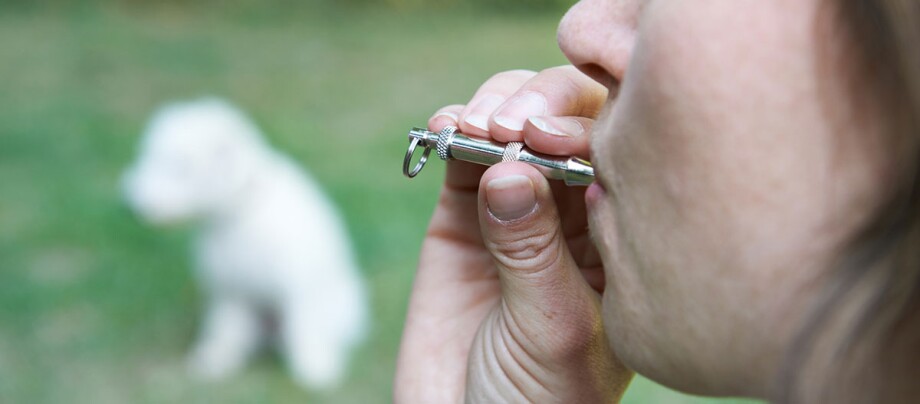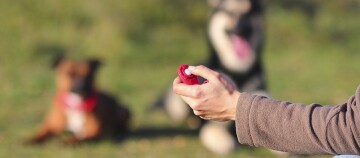Dog Whistle Training – Effectively Call Your Dog Using a Whistle
07.10.2022 - Reading time: 4 minutes

Dog whistle training is a proven and practical training method to call your dog over large distances when they are off the lead without having to use your voice. Training is simple. You just need patience and consistency. Read our guide on whistle training with tips on how to effectively call your dog using a whistle here.
The dog whistle is always to hand
Many dogs will hear the rustling of a bag of treats in the kitchen when they are playing in the garden. Even the quietest of clicks when opening a tin of food will be heard through a closed door. Yet sometimes it seems that our dogs go “deaf” whenever the commands “here” or “come” are given, or even when you say their name. There are many reasons why dogs ignore spoken commands. Part of the reason for this is our own voices, another reason is the frequency of the commands being used, which, from the dog’s point of view, don’t always have a clear meaning.
Dog whistle training comes from work with hunting and herding dogs who have to be signalled over large distances with no visual contact and out of the range of our voices.
Summarising the advantages of training together with a dog whistle:
- Safety and composure they’re off the lead thanks to the “come” command
- Disruption of bad behaviour (e.g. chasing animals)
- More freedom for the dog when out walking
- Calls over larger distances
- Neutral command sounds without emotion and vocal fluctuations
The last point in particular is a big advantage of a dog whistle which shouldn’t be underestimated. Whenever you call out a command, your emotions such as anger, fear or impatience come across, which your dog understands very well, leading it to react with frustration or fear of being told off and refuse to come back. Our vocal modulation and pronunciation can also vary, not to mention that people tend to use filler words and variations when speaking commands By using a dog whistle, our signals are always clear, neutral and consistent.
All dogs can learn commands given with a whistle
In general, all the commands you give your dog such as “sit”, “lie down” or “no” can be trained with a dog whistle. However, the most important command with a whistle is “here” or “come” since this is the command that is given the most when your dog is running off their lead and will work best over long distances.
It is best to train a young puppy or dog with a dog whistle, although older dogs can also be trained as well. The most important thing is to have (much) more patience, calmness and consistency. Your efforts will be worth it in the end and your walks with your favourite friend will become much more relaxed.
Begin your whistle training step by step at home where your dog is not easily distracted. Consider which word you would prefer as a command to call your dog back. Maybe a short blast or four repeated sounds. It really doesn’t matter which one you choose. Just be consistent when you choose the one for you and use the same one when you are training your dog and not just for fun! Your dog will need three or four weeks to get used to the command from the dog whistle.
When using a dog whistle during training you should:
- When your dog is standing near you, blow the whistle and give them a special treat whilst looking at them. It should be something they don’t usually get which they particularly love, for example a piece of sausage, cheese or dried liver.
- Go further with the training by whistling when your dog is distracted. Use the whistle initially when they are only partially distracted and then later with stronger distractions.
- Practise with your dog in different situations, in different rooms and at different times of the day.
- Always give your student their special treat after whistling (the same, clear) sound. If your dog gets excited for the treat as soon as you put the whistle to your mouth, then you’re both doing things right.
Think about restricting the size of the snacks around meal times so that your dog doesn’t put on too much weight, and don’t expect too much at once from your pet. Be patient and practise for a couple weeks more at home before taking the training outside. If your dog doesn’t hear the whistle outside and doesn’t come back to you, don’t be mad at them. Just take the training one step back. Impatient whistling is a no-no.
Choosing the right dog whistle
There is a wide range of dog whistles on the market. They can be differentiated by design, material and the frequency they emit. Some can be heard by humans, others only by dogs (and other animals). Regardless of which one you choose, you should then stick to the same model. This ensures that you always use the same sound or frequency for which your dog is trained.
Tip: Choose a well-known dog whistle manufacturer since this increases the chances that you will be able to buy the same model in the future. Remember that with a new type of whistle, you may need to repeat the training.



